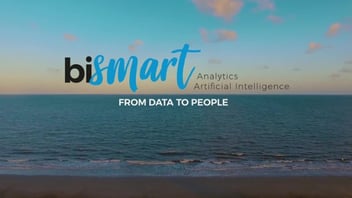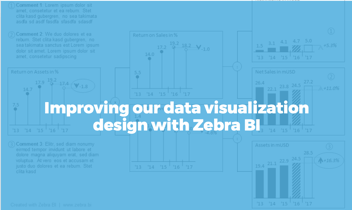Discover how Bismart's diagnostic data analysis helps you identify hidden causes and patterns to make informed, strategic decisions.
Diagnostic analytics is gaining increasing prominence in the field of data analytics. Unlike other methods that focus on describing past events or forecasting future trends, this approach delves into the underlying causes of events, offering a deeper understanding of the “why” behind the data.
Data analytics encompasses a wide range of techniques and methodologies, each serving a distinct purpose. Among them is diagnostic analytics —an approach that, despite being less widely recognized, plays a critical role in data-driven decision-making.
Acting as a bridge between descriptive analytics, which explains what has happened, and predictive analytics, which anticipates what might happen, diagnostic analytics provides essential context.
By uncovering the factors influencing results, it enables organizations to move beyond surface-level insights and make more informed, strategic decisions.
What Is Diagnostic Analytics?
Diagnostic analytics is a type of data analytics that aims to identify the underlying causes of past events by examining historical data and its correlation with other relevant factors.
In simple terms, diagnostic analytics seeks to answer the question: Why did this happen?
Unlike descriptive analytics, which focuses on summarizing what has occurred, diagnostic analytics goes a step further by uncovering the reasons behind those events. To achieve this, data analysts apply advanced techniques such as root cause analysis, anomaly detection, and statistical correlation. These methods help identify relationships between variables and understand how certain factors influence outcomes.
In the business world, diagnostic analytics plays a crucial role in optimizing processes, mitigating risks, and making informed decisions. For instance, in supply chain management, demand and supply planners rely on diagnostic analysis to detect deviations in demand, understand the causes of stock shortages or logistical inefficiencies, and adjust their strategies accordingly.
By providing a clear understanding of the factors that impact performance, diagnostic analytics becomes an essential tool for continuous improvement and truly data-driven decision-making.
The Four Types of Data Analytics and Their Business Impact
As mentioned earlier, there are four main types of data analytics, each with a distinct purpose and area of focus.
From describing past events to generating automated recommendations, these four approaches help answer different types of business-related questions, enabling organizations to gain deeper insights and drive more informed decision-making.
1. Descriptive Analytics: What Happened?
Descriptive analytics is the foundational level of data analysis, focusing on summarizing and visualizing historical data to provide a clear understanding of past events—whether distant, recent, or immediate.
As the most widely used type of analysis, it is commonly found in business dashboards that track operational activities and performance over time.
Example: A sales dashboard displaying monthly revenue figures and customer growth trends over a specified period.
2. Diagnostic Analytics: Why Did It Happen?
Diagnostic analytics is the next step after descriptive analysis, aiming to uncover the reasons behind observed events. While descriptive analysis answers what happened, diagnostic analysis delves deeper to explain why it happened.
This type of analysis leverages historical business data, integrating information from multiple internal sources to examine patterns, trends, and correlations.
Because diagnostic analytics is more complex, it requires multidimensional data structures and advanced analytical techniques such as slice-and-dice, drill-through, drill-down, and roll-up, which allow for data segmentation and exploration at varying levels of granularity. Additionally, it incorporates statistical models and analytical algorithms to provide a more precise context for business challenges.
The greatest advantage of diagnostic analysis is its ability to reveal hidden factors behind a phenomenon, offering deeper insights into business performance.
Example: A website experiences a sudden drop in traffic with no apparent cause. Through diagnostic analytics, it is discovered that the issue stems from an uneven distribution of internal links, affecting the indexing of certain pages by search engines.
3. Predictive Analytics: What Will Happen?
Predictive analytics leverages statistical techniques, mathematical modeling, and machine learning to forecast future trends based on historical data. While it does not guarantee absolute accuracy, it helps organizations anticipate scenarios and make more informed strategic decisions.
Example: A bank uses predictive models to assess a customer's risk of default based on their financial history and behavioral patterns.
4. Prescriptive Analytics: What Should Be Done?
Prescriptive analytics is the most advanced level and is based on artificial intelligence, optimization and simulation to recommend specific actions that maximize the desired results. It integrates predictive models with optimization algorithms to suggest the best possible strategy.
Example: Inventory management software automatically recommends adjustments in production and purchasing to avoid stock-outs or overstocks.
Diagnostic Analytics Techniques
Diagnostic analytics relies on advanced techniques to uncover the underlying causes of a phenomenon using historical data.
These high-complexity methods help identify patterns, relationships, and hidden factors that influence business outcomes.
1. Correlation Analytics
Correlation analytics is used to identify relationships between variables and determine which factors may be influencing fluctuations or anomalies. This technique is particularly useful for analyzing sales trends, product demand, and marketing campaign performance.
Example: A retail team examines the correlation between promotions, seasonality, and sales volume to determine which factor has the greatest impact on product demand.
2. Cause-and-Effect Analytics
This technique helps establish causal relationships between different events and assess the impact of specific factors on business outcomes.
It is often combined with multidimensional data models and drill-down analytics to explore information in greater depth.
Example: An operations analyst investigates delays in the supply chain and discovers that a combination of raw material shortages and shifts in demand has caused the issue.
Correlation vs. Causation
When analyzing relationships between variables, it is essential to distinguish between correlation and causation. If two or more variables are correlated, it means their directional movements are related. A positive correlation indicates that when one variable increases or decreases, the other follows the same trend. Conversely, a negative correlation means that as one variable increases, the other decreases.
In diagnostic analytics, it is crucial to remember that correlation does not necessarily imply causation. Just because two variables move together does not mean that one directly influences the other.
While identifying causation is the ideal outcome, correlation remains a valuable technique for uncovering patterns and gaining insights from data.
3. Slice-and-Dice and Drill-Down
These techniques enable the breakdown of large volumes of data into different dimensions, allowing for deeper analysis of underlying details and segmentation based on various criteria.
They facilitate anomaly detection and help uncover variations in business performance.
Example: A business analytics team notices a revenue decline in a specific region. By using drill-down analytics, they identify that the issue originates from an underperforming product category.
4. Statistical Modeling and Machine Learning
Advanced statistical models and machine learning algorithms help detect hidden patterns and make predictions based on past trends. These techniques include regression analysis, clustering, and time series analysis, allowing businesses to uncover complex relationships within their data.
Example: A bank leverages machine learning models to analyze fraud patterns in financial transactions and identify key factors that increase the risk of suspicious activity.
5. Diagnostic Regression Analytics
While some relationships between variables are evident, others require a more in-depth analysis, such as regression analytics.
This technique is used to determine relationships between two variables (simple linear regression) or among three or more variables (multiple regression). The relationship is expressed through a mathematical equation that represents the slope of the best-fitting line between variables.
Regression models can also be leveraged for forecasting, making them a key component of predictive analytics.
Example: An e-commerce store uses regression analytics to assess whether delivery times affect sales. The results reveal that longer shipping delays lead to lower sales volumes, confirming the impact of logistics on demand.
Tools for Diagnostic Analytics
Conducting effective diagnostic analytics requires specialized tools that enable the manipulation, visualization, and analysis of large datasets. Some of the most widely used tools include:
1. Microsoft Power BI
Microsoft Power BI is one of the most widely used business intelligence (BI) tools in the corporate environment. It enables advanced data analytics with capabilities such as drill-through, data segmentation, and data modeling.
Additionally, Power BI facilitates visual exploration of trends and the identification of correlations through interactive Power BI dashboards, allowing businesses to gain deeper insights from their data.
2. SQL and Relational Databases
SQL is essential for accessing and manipulating large datasets stored in relational databases. It enables analysts to explore patterns efficiently using advanced queries and joins across multiple tables, facilitating a structured approach to data exploration and correlation analysis.
3. Python and R for Statistical Analytics
Python and R are among the most widely used programming languages for data analytics and statistical modeling. They offer powerful libraries such as Pandas, Scikit-learn, and Tidyverse, which enable automated regression analysis, clustering, and cause-and-effect modeling. These tools provide a flexible and scalable approach to data-driven decision-making.
4. Data Warehousing Tools (Snowflake, Azure Synapse)
Data warehousing platforms consolidate data from multiple sources, enabling large-scale diagnostic analytics with high-performance processing. Tools like Snowflake and Azure Synapse Analytics facilitate complex data modeling, historical analysis, and cross-functional reporting, making them essential for businesses handling vast amounts of data.
5. Machine Learning Platforms (Azure Machine Learning, TensorFlow, DataRobot)
For advanced pattern analysis and root cause identification, machine learning platforms enable the training of predictive models and the application of automated correlation and segmentation techniques. Tools like Azure Machine Learning, TensorFlow, and DataRobot enhance the ability to detect complex relationships and uncover deeper insights within data.
Conclusion
Diagnostic analytics is an essential tool for any organization seeking to understand the reasons behind its results.
By uncovering the underlying causes of events, diagnostic analytics not only complements descriptive and predictive analytics but also provides the critical context needed to improve business performance.
With advanced techniques and specialized tools, companies can discover hidden patterns and key influencing factors, allowing them to proactively adapt to market challenges and make more informed, data-driven decisions.



